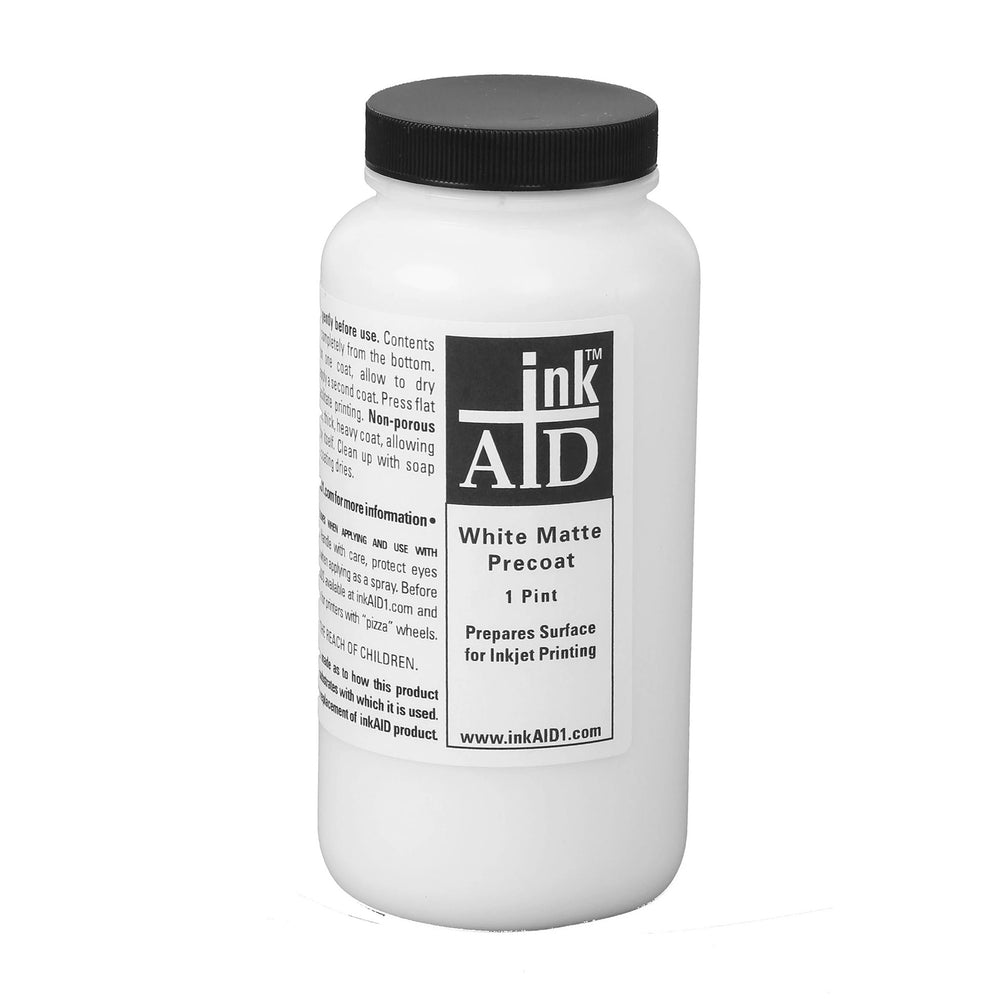





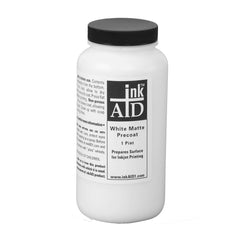
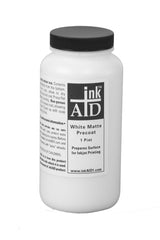
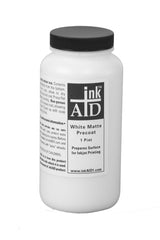
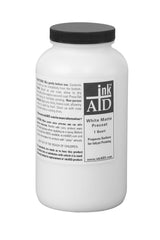


- $39.95
- $39.95
- Unit price
- per
Free Shipping
Free Ground Shipping in the Continental United States for orders of $150 or more.
inkAID White Matte Inkjet Receptive Coating can be applied to any material that can go through your printer. It provides a bright white, matte finish that will hide the underlying surface. It has excellent adhesion and can be used on both porous and non-porous materials. One moderately heavy coat usually provides sufficient coverage. It is very water resistant.
Instructions for using can be found by scrolling down this page to the "Working With White Matte Coating" Section and clicking the "⌄" sign.

"That Face", Dorothy Kuehn. Original photography printed on Tyvek first coated with molding paste and then coated with inkAID White Matte coating.
Working With White Matte Coating
xinkAID White Matte Coating…
Is an actual inkjet receptive coating. It can be used for coating onto any substrate: metal, paper, fabric, canvas, plastic, wood, practically anything that will go through your printer. This is the same coating found on commercially produced white matte inkjet media.
Provides excellent print quality. Produces clear, vibrant colors with deep blacks.
Has excellent adhesion to most materials.
Is extremely water resistant. inkAID White Matte coating, once dried, will not be affected by water. Wear appropriate attire when working with this coating.
Will not add a significant amount of thickness to your media. Substrates coated with inkAID White Matte coating will go through your printer just like any other material.
Is water based and very safe to use. It's in the same category as water based artist mediums and grounds. As with any coating, remember to use with adequate ventilation. Review the Safety Data Sheet for more information.
Using inkAID White Matte Coating
- All inkAID coatings work best at 70F – 80F, from initial stirring to application.
- Read and follow the directions on the label.
- Always stir the coating gently, but thoroughly, from the bottom of the container using a clean dry spatula or large spoon.
- inkAID White Matte coating cleans up with water, but is very water resistant after drying, so clean your tools promptly after use. Wear appropriate clothing and work in an area suitable for painting. Never work directly from the container. Always pour a working amount of inkAID White Matte coating into another clean container. Never pour unused coating back into the container.
- Make sure all of your tools and brushes are clean and dry before beginning work.
- Store inkAID White Matte coating in a cool, dry environment above 65F. Never allow the coating to freeze.
- The final appearance of your print will depend on how much coating is on the surface of the substrate. Be sure to thoroughly coat the entire surface of the substrate.
- It is the inkjet receptive coating that absorbs most of the ink and properly positions the ink droplets to create the print.
Porous substrates like paper, fabric, and canvas will absorb some of the coating into the material but enough is left on the surface to provide excellent printability. Usually, less coating can be used on porous substrates as they will absorb a significant amount of the ink vehicle. When getting started with a new substrate test a few small pieces.
Non-porous substrates like metal, plastic, and film will have all of the coating on the surface. With these substrates the coating must absorb all of the ink so a heavier coating layer is needed. Make sure your substrate is on a smooth level surface.
Always check your printer specifications to determine maximum media thickness for your printer.
inkAID coatings will impart a slightly stiffer hand to lighter weight papers and fabrics.
Applying inkAID White Matte Coating
- Always work with clean tools and brushes.
- inkAID White Matte coating can be applied with a foam brush, good quality bristle brush, coating rod, or a Paasche VLS Airbrush sprayer.
- When applying with a brush a good practice is to work in one direction and then again at a 90 degree angle to ensure complete coverage.
- inkAID White Matte coating is self leveling so brush strokes may not be able to be included in the inkjet receptive coating layer. Brush strokes and other embellishments can be added with the post print top coating step.
- When using a brush to coat metal or other non-porous substrate pour enough coating into the center and gently push the coating to cover the entire surface. You want a heavier coating layer so if some falls off the edges that's fine.
- A coating rod is a very easy and precise way to apply coating. Visit the Coating Rod product page to access a short video that demonstrates the process.
- Porous substrates like paper will absorb water and swell. This can cause slight curling upon drying.
- You can tape the substrate down to a working surface by using de-tackified blue painters tape. Coat the sheet and let it dry in place. De-tackify the tape by sticking it to cloth and pulling it off.
- This will add some fibers to the tape and reduce the adhesion. This will help protect the surface of your substrate when the tape is removed.
- Another way is to hang the wet coated substrate from a thin wire (using metal clips or clothespins to hold it in place) allowing gravity to pull it down and remain flat as it dries. Additional metal clips can be placed to the bottom of the hanging substrate to add additional weight.
If the substrate is still curled after drying, it can be pressed flat using several methods. One is to place it between two flat pieces of material such as plexiglas and loading a heavy weight on it overnight or for a few days. Another way would be to put sheets of parchment paper above and below the coated sheets and use a heat press or warm iron. Sheets can also be flattened by holding the top and bottom and running them over the edge of a table or counter top.
Larger sheets can be reversed rolled (coated side out) onto a 4 or 6 inch diameter cardboard tube to remove curl.
A Few Tips About Printing
- To print on very lightweight papers or fabrics you may have to attach them to a carrying sheet. A carrying sheet supports and stabilizes the coated substrate so you'll print exactly where you want to on the sheet. Visit the Carrying Sheet product page to access a short video showing how to set up and use a carrying sheet.
- The printer settings should be initially set to "matte" media. But, because you are working with a custom substrate, you should test several different media settings to find the best one.
Post Print Coatings (Top Coatings)
Top coatings, applied after printing, are used to provide the final finish to your print. They also provide scratch resistance, water resistance, and UV and ozone resistance which maintains the color (lightfastness) of your fine art print.
A water based top coating must be used over inkAID White Matte because it is very water resistant.
Recommended top coatings include Golden Polymer Varnish, and Premier Art Water based top coatings.
Recently Viewed Products
- Choosing a selection results in a full page refresh.








